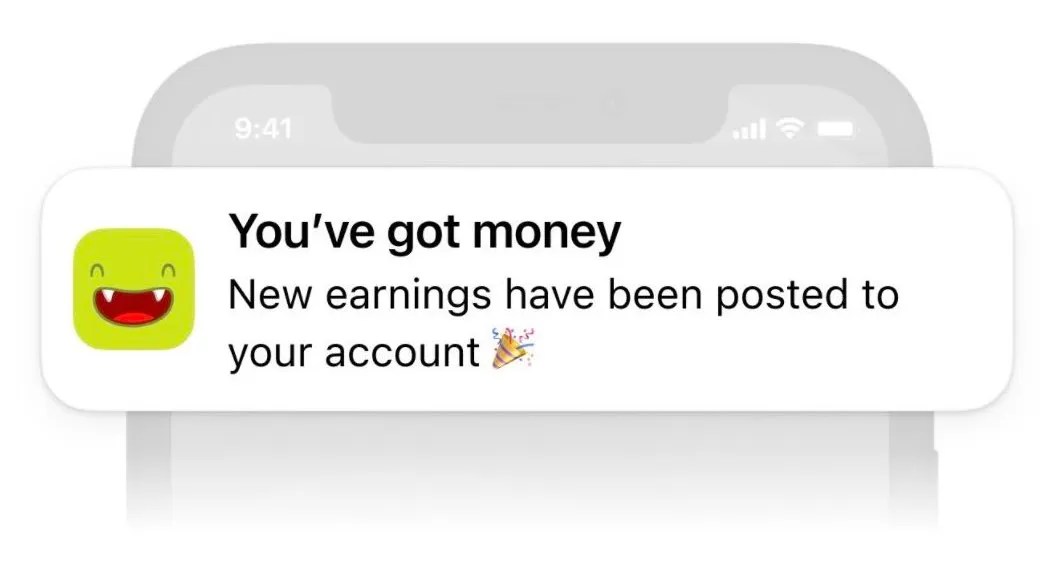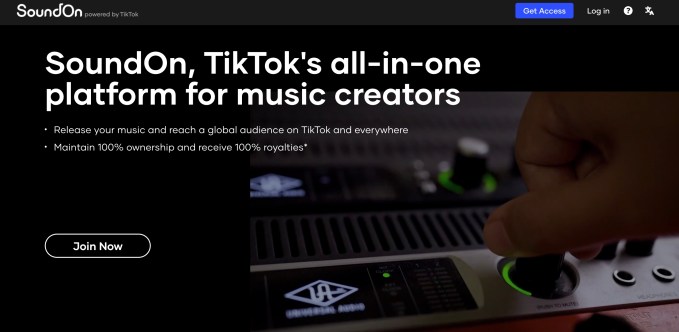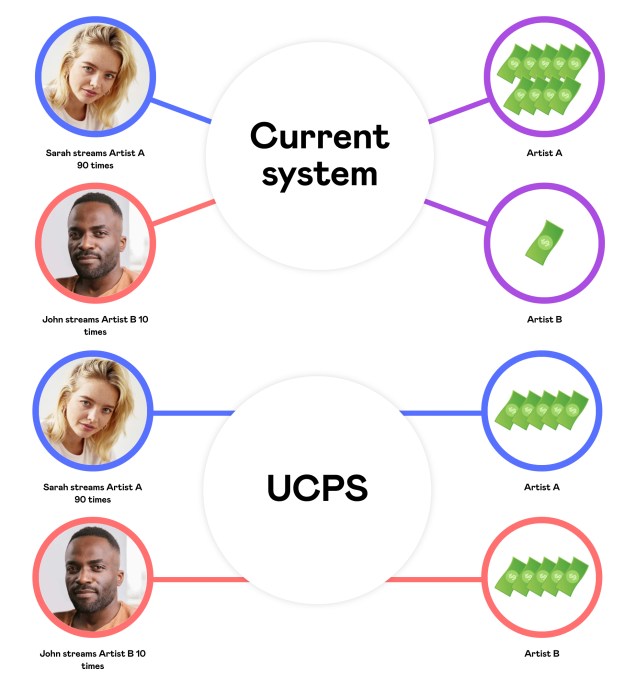DistroKid acquires website builder Bandzoogle to expand its toolset for artists
DistroKid releases new iPhone app, says Android launch coming soon
DistroKid, an independent music distribution service that musicians use to put music into online stores and streaming services, has released a new iPhone app that allows its users to upload new music, edit previous releases, check streaming stats and more all from their phones.
The new app allows artists, bands, DJs and producers to add lyrics or credits to releases, check earnings and manage which releases appear on their artist page in streaming services. In addition, the app includes a “You’ve got money” push notification that chimes every time new money hits your account.

Image Credits: DistroKid
“Musicians have been requesting a DistroKid app for a long time,” the company wrote. “But the majority of musicians still needed a laptop computer to access their music; so building a mobile app (in lieu of focusing solely on the desktop website) hadn’t hit super high priority. But more recently, (a) the proliferation of app-based DAWs, and (b) improvements in mobile filesystems like the iPhone “Files” app, meant the mobile experience can be awesome. So the time for a native DistroKid mobile app was nigh.”
DistroKid plans to continually improve the app and add new features. The company is also working on an Android app as well, but didn’t provide a potential release window for the launch.
The launch of the new app comes as the company unveiled a “intelligent mastering tool” called Mixea last month. The tool, which costs $99 a year for unlimited access, optimizes bass, compression, stereo enhancement and more to make music “radio ready” instantly. Last year, DistroKid launched a new music video distribution service called DistroVid to allow any artist to upload an unlimited number of music videos to Apple Music, Amazon Music, Tidal and Vevo. The membership costs $99 annually.
Founded in 2013, DistroKid’s most recent investment from 2021 put the company’s valuation at $1.3 billion. At the time, DistroKid said more than two million artists use its service.
DistroKid releases new iPhone app, says Android launch coming soon by Aisha Malik originally published on TechCrunch
Music distributor DistroKid expands into music video distribution with ‘DistroVid’
Record labels used to be the one ticket into the music industry. Now, it’s easier than ever for struggling musicians to get their music and video content out there. DistroKid, an independent music distribution firm, launched its new music video distribution service called DistroVid to allow any artist to upload an unlimited number of music videos to Apple Music, Amazon Music, TIDAL, and Vevo.
The company also noted that more digital service providers will come online in the coming months. According to DistroVid’s website, the service covers YouTube as well. The membership costs $99 annually, and users can add additional artists for $49.99 annually.
“Many streaming services have begun playing music videos in addition to audio–but until now, there hasn’t been a great way for independent artists to get their music videos into these services,” Philip Kaplan, Founder, and CEO of DistroKid said in a statement. “Our new music video service, called DistroVid, makes it super easy & affordable for independent artists to get their music videos everywhere.”
The new service could help streamline video distribution for independent artists as it is typical for video distribution services, like Symphonic and Ditto Music, to charge one-time fees of $95 to $99 per music video upload. With DistroVid, artists pay the same price once each year and can upload unlimited music videos. Also, DistroKid pays artists 100% of their earnings, whereas some competitors pay 70%.
From an artist’s perspective, DJ Hoppa said DistroVid is a “game-changer” for independent labels and artists. “I’ve always stressed the importance of music videos to every artist we’ve worked with – videos really help give potential fans a way to connect with both the artist and their music,” said DJ Hoppa, founder of label Broken Complex. “Up until now, it’s been expensive and difficult to add my music videos to streaming services, which means our fans are forced to bounce between different apps to see them. DistroVid changes all that. The new tool makes it easy and affordable to upload as many videos as I want, then send them directly to where fans are already listening to my music. DistroVid is going to be a game-changer for my independent label and for independent artists everywhere.”
The video distribution service was first tested last month. Some DistroKid artists criticized the company for the annual price. DistroKid tweeted a response:
Originally, DistroKid was planning to charge non-members $129 per year. However, this is no longer reflected on the website.
Another affordable option is PeekSound, which charges artists $80 per year for unlimited music videos—a $19 difference from DistroVid. The catch is that PeekSound does not distribute music videos to TIDAL and charges an extra fee for Apple Music and Vevo. Also, artists have to upload videos to their YouTube profiles themselves. PeekSound users keep 100% royalties.
DistroKid was founded in 2013 and currently serves around two million artists. The music distribution company was one of the few trendsetters to switch from a pay-per-release model to an annual-fee model. Recently, rival TuneCore overhauled its pricing structure for the first time in 16 years to bring itself closer to DistroKid’s pricing structure.
Last year, DistroKid received investment from software investor Insight Partners, valuing the company at $1.3 billion. The company also unveiled two programs in 2021. One is a program called “DistroKid Upstream” for streaming data-sharing and the other is a Twitch affiliate partnership program.
TikTok launches a music distribution platform, SoundOn
TikTok has already achieved massive influence in today’s music industry, sending songs that find popularity on the app to the top of the Billboard charts. Now the company is launching its own music marketing and distribution platform, SoundOn, to help more artists get their music heard. The new platform allows artists to upload their music directly to TikTok and to parent company ByteDance’s own music streaming service Resso, in addition to global streaming platforms including Apple Music, Spotify, Pandora, Deezer, and Tencent’s Joox.
This distribution is provided free of charge and all transaction fees are being waived by the platform. TikTok says SoundOn will pay 100% of royalties to music creators for an unlimited time on Bytedance-owned platforms. This includes distribution to TikTok; plus Resso in Brazil, Indonesia, and India; and to ByteDance’s video editor app, CapCut.
For global streaming services, the payout is also 100% in the artist’s first year, but will drop to 90% in year two and beyond. By comparison, competitor DistroKid charges artists and labels on a subscription basis, while allowing artists to keep 100% of their earnings. TuneCore, meanwhile, charges for distribution on a per-song or per-album basis, but also promises artists keep 100% of streaming revenues.
According to SoundOn’s FAQ, artists will retain all rights and royalties, meaning they’ll own their masters in addition to receiving 100% of royalties (or later, 90%).

Image Credits: TikTok
Beyond its handling the mechanics of music distribution, SoundOn offers other promotional tools and support, including audience insights and development, advice from the SoundOn marketing team, access to TikTok’s song tab (where music is linked on profile pages), TikTok verification, editorial placements on Resso and Capcut, and promotional support through creator marketing on TikTok’s platform.
The SoundOn website notes that releasing through its platform will get tracks in front of TikTok creators.
“TikTok creators are the lifeblood of our platform and the reason sounds become hits,” the website explains. “When you release through our platform, our team will activate diverse creators to make videos with your track. This helps you broaden your fanbase and reach new communities that these creators are a part of.”
The TikTok marketing aspect to SoundOn’s value proposition could make the service particularly appealing to new and emerging artists, as they understand that being given an extra push on TikTok can help them to break out and reach a wider audience, thanks to TikTok’s viral trends. Fans then follow artists on music streaming services, where that loyalty is converted into actual dollars and cents.
“New artists and musical creators are a vibrant community within TikTok and SoundOn is designed to support them as they take the first steps in their career,” said Ole Obermann, Global Head of Music at TikTok, in a statement about the launch. “Our SoundOn teams will guide creators on their journey to the big stage and bring the expertise and power of TikTok to life for the artist. We’re incredibly excited about how this will surface and propel new talent and how SoundOn will contribute to an increasingly diverse and growing global music industry.”
The SoundOn platform had been in beta testing since last fall, and is now fully available in the U.S., U.K., Brazil and Indonesia, with an undisclosed number of artists and creators already using the service, including Muni Long, Games We Play, Abby Roberts and Chloe Adams in the U.K.
SoundOn is not TikTok’s first move into the music distribution space. The company in 2020 announced a deal with UnitedMasters, which became the first music distribution company to be integrated into TikTok.
ByteDance’s expansion into music distribution is not unusual for streaming service operators. Apple invested in UnitedMasters last year, for example, which also has large deals with the NBA and ESPN, in addition to TikTok. And Spotify has a small stake in DistroKid — though it sold off two-thirds of that stake for $167 million last fall.
TikTok says interested artists can now register for SoundOn at us.soundon.global or soundon.global.
Tidal is investing in direct artist payments, a step toward fair streaming payouts
Tidal and DistroKid, a popular independent music distributor, teamed up last week to introduce a direct artist payments system. This partnership foreshadows a larger pivot from Tidal toward experimenting with streaming payout models that are thought to distribute funds more equitably to musicians who don’t get millions of streams on any given day (AKA, people who aren’t Taylor Swift or Lil Nas X).
If you’re subscribed to Tidal’s HiFi Plus plan — which costs $19.99 per month — up to 10% (or about $2) of your monthly subscription fee will be distributed to your most-listened-to artist (so long as that artist uses DistroKid). That percentage shrinks if you’re paying for your subscription through a service that takes a cut, like the Apple or Google app stores. Tidal told TechCrunch that it also struck similar deals with independent distributors like CD Baby, Equity Distribution, Stem, Symphonic, Tunecore and Vydia.
This model is an example of a user-centric payment system (UCPS), which is generally favored by artists. As described by Deezer, a streaming service that uses UCPS, this system helps individual fans more directly and transparently support their favorite artists, since their subscription fee is distributed to the artists they listen to. So, let’s say you listen to a 10-track record one time on a platform that pays about one cent per stream, like Apple Music. Then, that artist will earn 10 cents (and that’s before distributors and publishers take their cut). But, on a UCPS platform like Deezer or SoundCloud, if you listen to 10 albums from 10 different artists in a month, then a portion of your monthly subscription fee is divided among those 10 artists, which means they’re probably getting more than 10 cents each. It’s similar to buying a CD — it’s not how often you listen to that CD, but rather, the fact that you bought it in the first place.
Tidal told TechCrunch that beyond its deals with independent distributors, a kind of UCPS will come to its HiFi Plus tier starting in January 2022. The platform says it teamed up with more than 100 labels — both major labels and independents — to develop what it calls its fan-centered royalties program.

Image Credits: Deezer
Currently, major streaming platforms like Apple Music and Spotify pay per stream. But the growth of music streaming services — an attempted answer to the crisis of music piracy — has been, on the whole, not great for musicians. Musicians’ primary source of revenue is now touring, so when the pandemic hit and canceled a slew of concerts, the inequity of streaming payouts became even clearer.
Last year, the Union of Musicians and Allied Workers (UMAW) launched a campaign called Justice at Spotify, which demands the streaming giant to adopt UCPS, increase transparency about payouts and pay at least $0.01 per stream. As it stands, the platform is estimated to pay an average of $0.0038 per stream, according to the UMAW, but Spotify itself doesn’t disclose this value, saying that pay per stream is not a meaningful value to analyze.
“We applaud Tidal’s move toward a more user-centric payment system, a shift we’ve been demanding since we launched our Justice at Spotify campaign in 2020, and one already adopted by Deezer and SoundCloud,” said Joey DeFrancesco in a statement to TechCrunch on behalf of UMAW. “User-centric is no silver bullet, and we still desperately need more fundamental changes in streaming royalties, but it is a step in the right direction.”
Comparatively, Apple Music pays $0.01 per stream on average, per an internal memo leaked earlier this year. Tidal is thought to pay about the same, though the company itself hasn’t confirmed these numbers. But Spotify, which has the most subscribers out of the three streaming leaders, pays the least.
Spotify points out that it appears to pay less per stream than competitors because, according to the company, Spotify users stream more music than users on competitor platforms. Also, unlike Apple Music or Tidal, Spotify offers a free tier, subsidized through ads, which the platform says might skew its pay-per-stream metrics.
Streaming payouts don’t directly reach the artist — first, payouts are divided among an artist’s record labels and publishers. The amount that an individual artist will get per stream depends on their contracts in the industry. But for now, according to the UMAW, an independent artist would need to amass 283,684 Spotify streams per month to pay a monthly rent of $1,078, the U.S. national median.
Spotify took a minority stake in DistroKid in 2018, but just weeks ago, Spotify’s quarterly SEC filing revealed that it sold two-thirds of its equity interest in the independent distributor for €144, or about $163 million. It’s interesting timing for DistroKid to immediately strike a deal with Tidal, a more musician-friendly service, to enact a version of the policies that the UMAW are demanding from Spotify.
But Spotify doubts how much user-centric payments would actually benefit artists. A study from the National Music Center in France found that yearly payouts would fluctuate by “at most a few euros” for artists outside the top 10,000 acts.
“We are willing to make the switch to a user-centric model if that’s what artists, songwriters and rights holders want to do. However, Spotify cannot make this decision on its own — it requires broad industry alignment to implement this change,” says the platform’s website.
So, perhaps the model of Tidal’s deals with independent distributors — a variation of UCPS — could be more beneficial for artists. A $2 per month bonus per user for being their most-streamed artist could add up. But, industry-wide changes like these may require trial and error to determine how streaming platforms can run their businesses while also paying musicians fairly for access to their music.


 Still we totally understand folks want an even better value and you can count of us to bring it
Still we totally understand folks want an even better value and you can count of us to bring it 